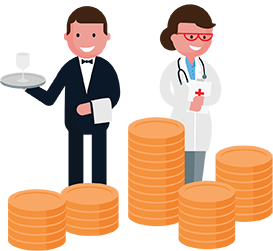Gender equality
How equal are men and women in Denmark? This theme features a selection of key indicators illustrating some of the differences and similarities between the lives of men and women. For example, you can see what the gender equality situation is in areas such as education, health and income.
Earnings
When talking about gender equality, the subject of pay often comes up – or rather equal pay. In 2023, the female population earned an average of 12.3 per cent less than the male population. The pay gap has been calculated as the difference between men and women’s earnings, in proportion to men’s earnings.
The pay gap varies depending on the work function performed. Here you can see the pay gap for general practitioners and waiters. For other selected work functions, the pay gap was 18.9 per cent for authors; 12.2 per cent for real estate agents and property managers; 1.6 per cent for cashiers and -1.7 per cent for physiotherapists and relaxation therapists.
Gender pay gap for selected work functions


Income
In 2024, couples where the woman earns more than the man accounted for 29.2 per cent of all relationships (with an average age between 20 and 64 years). This share has increased by 10.2 percentage points since 1987.
In 2023, the pension assets of 60-69-year-old men were on average 17 per cent higher than those of women of the same age. This gap has been calculated as the difference between men and women’s pension assets, in proportion to men’s pension assets, and it has steadily narrowed since 2014 where it was 24 per cent.
Pension assets gap for 60-69-year-olds


Family
Of parents who had children under 6 years living with them in 2023, the men worked on average 2.9 hours more per week than the women.
On August 2, 2022, a new parental leave act came into effect. It gives equal rights to men and women giving both parents 11 weeks each of earmarked parental leave and an additional 13 weeks each to be freely divided between the parents. The parents of 2023 are the first to take parental leave under the new rules. Compared to the 2021 parents, new fathers in 2023 took 29.3 more days of leave, while mothers took 36.5 fewer days. As a result, fathers in 2023 took about one fifth of the total parental leave.
Average no. of parental leave days of mothers and fathers with newborn babies


Work
Of employees who had children under 6 years living with them in 2023, approximately twice as many mothers as fathers were working part-time (less than 32 hours per week).
79.2 per cent of all men and 75.8 per cent of all women were in employment - either part-time or full-time.
Employment rate for men and women, 16-64 years


Education
In the 30-34-year-old population, more women than men had long-cycle higher education as their highest educational attainment in 2024. This trend has been prominent since 2003.
In 2024, more than twice as many boys as girls received special needs education in basic school.
Boys and girls receiving special needs education in basic school


Safety
In 2024, approximately 12,800 women and 14,900 men were victims of violence in Denmark. This corresponds to 0.4 per cent of the female population and 0.5 per cent of the male population.
However, it is much more often men than women who commit acts of violence. In 2024, male offenders accounted for five in six convictions for violence.
Men and women convicted of violence


Health
The life expectancy for women born in 1983-1984 is six years longer than that of men born in the same period (77.5 and 71.5 years respectively) While it is anticipated that life expectancy will be longer for the new generations, the life expectancy gap is expected to narrow. For girls and boys born 40 years later, in 2023-2024, the gap is 3.8 years.
In 2023, women visited their general practitioner more often than men did. On average, men were in contact with medical professionals 5.9 times, while women were in contact with medical professionals 8.7 times.
Men and women’s consultations with general practitioners


Democracy and management
After the Danish parliamentary elections in 2022, 43.4 per cent of the elected candidates were women, which is historically the closest the Danish Parliament has come to an equal candidate distribution between the sexes. Overall, women’s share of both elected and nominated candidates has increased steadily since 1943, when women accounted for 1.4 per cent.
In 2023, women accounted for 21 per cent of the members of Danish boards of directors and 16 per cent of the executive boards – a level that has remained fairly constant since 2014.
Share of women on boards of directors and executive boards


Culture
In 2024, almost twice as many women as men borrowed materials from the Danish public libraries. The figures in the chart cover both borrowers of physical materials in the libraries (books, DVDs, etc.) as well as of digital materials from eReolen.
In 2023, 55.2 per cent of the recipients of support for cultural activities from the Ministry of Culture were men and 44.8 per cent were women. The women’s share has increased since 2010 when it was at 38.5 per cent.
Men and women’s shares of the Ministry of Culture’s support for cultural activities


Read more
How equal are men and women in the EU? In Eurostat's interactive publication "The life of women and men in Europe”, you can compare the daily lives of men and women across the European countries.
Visit "The life of women and men in Europe"
Similarly, the European Institute for Gender Equality, EIGEEIGE, each year publishes a "Gender Equality Index", which compares European men and women on parameters such as power (political and social), time (for example spent on caring for children) and knowledge.
Visit the EIGE "Gender Equality Index"
Explore EIGE’s database
Danish KVINFO is a knowledge centre for gender and equality and makes surveys on sexism, sexual harassment and discriminatory practices based on gender.
Visit KVINFO
Nordic Information on Gender, NIKK, is a Nordic cooperation body under the Nordic Council of Ministers. They gather knowledge and communicate facts and research in the area of gender equality and equal rights for LGBTI people with a Nordic and cross-sectorial perspective.
Visit NIKK
In the OECD, "The OECD Gender Initiative" collects data on gender equality in education, employment and entrepreneurship, in both OECD and non-OECD countries.
Visit "The OECD Gender Initiative"
Like Eurostat, The United Nations Economic Commission for Europe, UNECE, collects statistics on gender equality in Europe. The gender statistics cover areas such as crime and violence, public life and decision making, as well as employment and finances.
Visit the UNECE’s gender statistics
On the website of the Ministry of Digital Government and Gender Equality, you can see, for example, the political deals made and the initiatives launched in the gender equality area.
Visit the Ministry of Digital Government and Gender Equality
Contact persons for this theme page
Annemette Lindhardt Olsen Dorthe Larsen
T: 39 17 30 13 T: 39 17 33 07
E: alo@dst.dk E: dla@dst.dk

